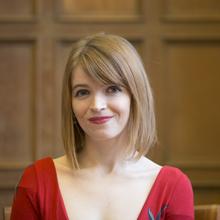
February 8, 2024
Anna Arays is the Librarian for Slavic and East European Studies at Yale University.
What was your journey to becoming a librarian and joining the Yale community?
I’ve been working in libraries since I was a teenager, but I never considered becoming a librarian until an English class I took my second year of college, where we went to the library’s special collections reading room to look at 19 th century women’s journals. I had been thinking about careers in museums at that point, but I was immediately captivated by the idea of working with rare books, which we were encouraged to touch and interact with instead of just observing from a distance. I immediately went to the curator and asked for a job, and for the remainder of my time in college I worked as his assistant, in addition to a job with campus IT. By the time I graduated and went to library school, I had a pretty good toolkit of bibliographic and computer skills, which I augmented with a Master’s in Russian and East European Studies. Those combined skills served me well in my first job as a cataloger at Ohio State, where I worked from 2014-2016, mostly cataloging Slavic manuscripts from the collection of the Hilandar Research Library. In 2016 I was hired to be the Librarian for Slavic, East European, and Eurasian Studies at Yale, and it has been my home ever since!
In your role as a librarian for Slavic, East European, and Eurasian Studies, which covers expansive territory, historiography, and scholarship, what are the primary responsibilities and challenges you face?
As the librarian for this subject area, I serve as selector for the various print, digital, and audiovisual collections from and about the region that Yale scholars rely on for their research. I also help researchers discover those collections in our local catalogs, offer guidance and assistance about their research processes, and publicize collections through events, exhibits, and other programming. The expansive territory this subject area covers is indeed one of the challenges, but thankfully Yale scholars have access to a tremendous network of interconnected collections that augment our own holdings. Making sure the materials we receive are relevant and maintaining good relationships with vendors in many different places are two of the ways I keep up with this aspect of my job. Another is keeping up with events and people in programs like REEES and the European Studies Council, as well as departments like Slavic Languages and Literatures and History. Knowing our user community well helps make the work of keeping our local collection in scope more manageable.
Can you elaborate on your interactions and collaborations with Yale students? What aspects do you find most fulfilling in working directly with students?
Working with students and faculty is by far my favorite part of the job – our community is full of curious, ambitious, engaged people who are a joy to work with and really value their library. The scope of those interactions can vary. I meet with a lot of undergraduates every year who are working on term papers or senior essays, and they might need assistance with anything from identifying primary sources about their topic to using the library catalog effectively to puzzling out difficult citations. Graduate students working on advanced topics often seek advice about sources or pose challenging reference questions; recently they’ve also sought advice about applying to research fellowships to work in specialized collections. At its core, librarianship is a service profession, and I think the times I find the work most fulfilling are the times when I watch students have ideas, make connections, and experience breakthroughs. Helping someone read a sentence in terrible cursive, locating a book they’ve tried everything to find, suggesting source types they hadn’t considered – these are all varieties of advice I dispense regularly, and it’s always such a delight when it really helps someone get something done.
Tell us more about your involvement with the East Coast Consortium of Slavic Library Collections. How would you describe the ECC’s mission and its importance?
The East Coast Consortium of Slavic Library Collections began in 1993 as a collective working to establish new and better collecting practices in the wake of the Soviet Union’s collapse. Over time it has evolved into a network that supports research in our region in multiple ways, including collective collecting initiatives the widen the scope of what users have access to, web archiving efforts that are preserving important and vulnerable websites from across Eastern Europe and Eurasia, and research guides that leverage our collective knowledge to provide wider access to an increasingly wide and varied digital landscape. It has been an invaluable way to work strategically with colleagues across the East Coast, particularly since it brings together multiple types of research institutions, including public, national, and academic libraries.
Among all the library collections at Yale, do you have a favorite? If so, what makes it stand out for you?
It’s very hard to pick a favorite! The breadth and variety of our collections – plus the fortunate position I’m in, where I get to see so many as part of my day-to-day work –means that I get excited about a lot of things we own. There are literary papers of people like Nina Berberova and Czeslaw Milosz, which offer such rich histories of these people’s creativity as well as their connections to American academia and émigré life. There are unexpected gems like public health posters in our Medical Historical Library and richly illustrated Slavic manuscripts at the Beinecke. For me personally, the most meaningful collections lie in the University Librarian’s records and the papers of Aleksis Rannit, Yale’s first Slavic curator. This is a library, and a collection, with a fascinating history that has been a pleasure to explore.
CAI Type:

